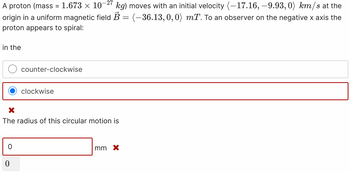-27 A proton (mass = 1.673 x 10 kg) moves with an initial velocity (14.32, 3.03, 0) km/s at the origin in a uniform magnetic field B = (-17.79, 0, 0) mT. To an observer on the negative x axis the proton appears to spiral: in the clockwise counter-clockwise The radius of this circular motion is mm
-27 A proton (mass = 1.673 x 10 kg) moves with an initial velocity (14.32, 3.03, 0) km/s at the origin in a uniform magnetic field B = (-17.79, 0, 0) mT. To an observer on the negative x axis the proton appears to spiral: in the clockwise counter-clockwise The radius of this circular motion is mm
Related questions
Question

Transcribed Image Text:A proton (mass = 1.673 × 10-27 kg) moves with an initial velocity (14.32, 3.03,0) km/s at the origin
in a uniform magnetic field B = (-17.79, 0, 0) mT. To an observer on the negative x axis the proton
appears to spiral:
in the
clockwise
counter-clockwise
The radius of this circular motion is
mm
Expert Solution
This question has been solved!
Explore an expertly crafted, step-by-step solution for a thorough understanding of key concepts.
This is a popular solution!
Trending now
This is a popular solution!
Step by step
Solved in 5 steps

Follow-up Questions
Read through expert solutions to related follow-up questions below.
Follow-up Question
How come this is not clockwise by the same reasoning?

Transcribed Image Text:A proton (mass = 1.673 × 10-27 kg) moves with an initial velocity (-17.16, -9.93, 0) km/s at the
(-36.13, 0, 0) mT. To an observer on the negative x axis the
origin in a uniform magnetic field B
=
proton appears to spiral:
in the
0
counter-clockwise
X
The radius of this circular motion is
0
clockwise
mm x
Solution